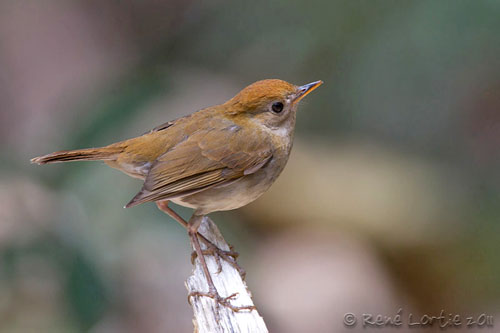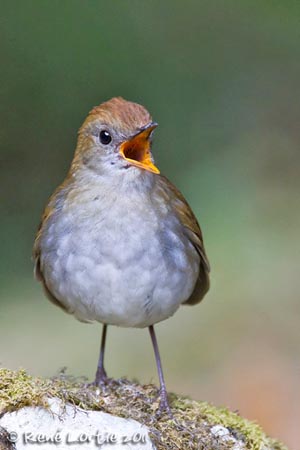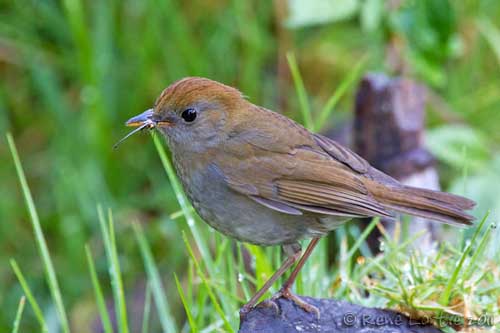
Fr: Grive à calotte rousse
All : Bergmusendrossel
Esp : Tordo de Capa Rojiza, Zorzal corona rojiza, Zorzal de Frantzius, Zorzal gorrirrojizo,
Ital : Tordo usignolo di Frantzius
Nd : Bergdwerglijster
Sd : Rosthättad skogstrast
Photographer:
René Lortie
http://rlortie.ca/
Text by Nicole Bouglouan
Sources:
HANDBOOK OF THE BIRDS OF THE WORLD Vol 10 by Josep del Hoyo-Andrew Elliott-David Christie - Lynx Edicions - ISBN: 8487334725
THRUSHES by Peter Clement and Ren Hathway – HELM - ISBN: 0713639407
A GUIDE TO THE BIRDS OF MEXICO AND NORTHERN CENTRAL AMERICA by Steve N. G. Howell, Sophie Webb - Oxford University Press - ISBN: 0198540124
BirdLife International (BirdLife International)
Neotropical Birds – Cornell Lab of Ornithology
Wikipedia, the free encyclopaedia
Ruddy-capped Nightingale-Thrush
Catharus frantzii
Passeriforme Order – Turdidae Family
BIOMETRICS:
Length: 15 5 – 18 cm
Weight: 28-32 g
DESCRIPTION:
The Ruddy-capped Nightingale-Thrush is a shy, solitary bird, a common resident in its range but infrequently seen. It is often heard before to be seen.
The adult of the nominate race has bright rufous-brown crown and nape, giving the species its name. Its plumage is shading to brownish-olive on the upperparts, including wings and tail. The face is rather greyish. The throat is paler, mostly whitish with dark streaks spreading on to the grey breast and rest of underparts, except on the whitish belly and undertail-coverts.
The bill has black upper mandible and yellow lower mandible. The eyes are dark brown. Legs and feet are flesh-coloured.
Both sexes are similar, but the female may differ in extent of grey and greyish-buff on the breast. Some females can be whiter on belly.
The juvenile resembles adults with duller crown, mostly dark olive-brown. The upperparts are finely mottled due to paler centres of feathers. On the underparts, the breast is dull olive with darker tips to feathers, forming bars on lower breast, belly and flanks.
There are 8 subspecies which slightly differ in tones and extent of greyish and brownish washes on breast, back and crown.
The nominate race C.f. frantzii from Costa Rica is here described and displayed.

VOICE: SOUNDS BY XENO-CANTO
The Ruddy-capped Nightingale-Thrush utters a sharp, rising whistle “whooeeet” or a quavering “wheeer” as contact calls. The alarm notes are a hoarse “work” and a harsh “correeee”.
The song is a series of musical notes including fluty trills, whistles and warbles “shee-vee-li-ee-ree” interspersed with short pauses.
It often sings more at the onset of the rainy season. The song is usually given in the early morning and the evening, from low, concealed perch.
HABITAT:
The Ruddy-capped Nightingale-Thrush frequents dense damp understorey of wet to semi-humid forests and thickets, forest edges and clearings, ravines and varied vegetation in areas between 1350 and 3500 metres of elevation.
RANGE:
The Ruddy-capped Nightingale-Thrush ranges from C Mexico through Central America to W Panama.
BEHAVIOUR:
The Ruddy-capped Nightingale-Thrush feeds mainly on insects, various invertebrates and spiders. It follows the ant swarms and also takes numerous berries.
It forages on the ground and in low vegetation, in bushes, thickets and undergrowth. It can be seen sometimes on roadsides and in pastures bordered by tall vegetation, but it is never far from cover.
It moves by hopping or bounding on the ground. Like several Turdidae species, it sometimes holds the wings below the level of the tail when on the ground. Where it is about to fly, the head is lowered horizontally while opening the wings.
During the breeding season, the male defends its territory by giving advertising songs. The pair forms at the beginning of the breeding season, and they are monogamous.
There is not available information about the courtship behaviour of the Ruddy-capped Nightingale-Thrush.

FLIGHT:
The Ruddy-capped Nightingale-Thrush does not travel long distances, but only performs short flight between its feeding areas. This bird is mainly terrestrial.
REPRODUCTION:
The breeding season varies according to the range, and occurs in June in Mexico, between February and June-August in El Salvador, and between April and June in Costa Rica.
The nest is a bulky cup made with green moss, weed stems, plant fibres, vines and dry grass. The inner cup is lined with rootlets, dry leaves and fine grass, with sometimes horsehair.
This structure is often placed near a stream, between 1 and 4 metres above the ground in forest undergrowth, fern-clump or shrub.
The female lays two pale greenish-blue eggs with heavy dark mottling. She incubates during 15-16 days. The chicks are fed by both parents, and fledge about 14-16 days after hatching.
This species produces a single brood per season.
DIET:
The Ruddy-capped Nightingale-Thrush feeds on numerous insects’ species, spiders and other invertebrates. It also consumes berries and sometimes follows ant swarms. It forages on the ground.
PROTECTION / THREATS / STATUS:
The Ruddy-capped Nightingale-Thrush is usually fairly common throughout its range. This species has benefited from scrub expansion due to clearance of rainforest. This is a shy bird, making it difficult to see.
The species is not currently threatened.
